
Written and compiled by Gary Kukis
These studies are designed for believers in Jesus Christ only. If you have exercised faith in Christ, then you are in the right place. If you have not, then you need to heed the words of our Lord, Who said, “For God so loved the world that He gave His only-begotten [or, uniquely-born] Son, so that every [one] believing [or, trusting] in Him shall not perish, but shall be have eternal life! For God did not send His Son into the world so that He should judge the world, but so that the world shall be saved through Him. The one believing [or, trusting] in Him is not judged, but the one not believing has already been judged, because he has not believed in the Name of the only-begotten [or, uniquely-born] Son of God.” (John 3:16–18). “I am the Way and the Truth and the Life! No one comes to the Father except through [or, by means of] Me!” (John 14:6).
Every study of the Word of God ought to be preceded by a naming of your sins to God. This restores you to fellowship with God (1John 1:8–10). If we acknowledge our sins, He is faithful and just to forgive us our sins and to cleanse us from all unrighteousness (1John 1:9). If there are people around, you would name these sins silently. If there is no one around, then it does not matter if you name them silently or whether you speak aloud.
|
|
|
|
|
|
|
|
|
Preface: The Material below came primarily out of Leviticus 11. At some point I will need to organize what I have here and perhaps add some additional material. However, this document summarizes the topic reasonably well.
1. In
Leviticus 11 is a classification of animals as to whether or not they are clean. Primarily, these are dietary laws which blend into the spiritual life insofar as some things are strictly clean and some things are strictly unclean, as people are saved or not saved; you are filled with the Spirit or you are not; you are producing divine good or you are not.
One detail which may occur to the reader is that much of this chapter is disputed when it comes to the translation of which animals are actually being spoken of in terms of being clean or unclean; why would God allow such a large portion of one chapter to become linguistically lost, so to speak? The answer is simple: we are not under the dietary laws of Israel so we do not need a lot more than the principles which we might gain here or there. For this reason, there will not be a lot of text accompanying each verse.
The concept of animals being clean or unclean did not originate with this chapter, but can be found back as far as Genesis 7:2. So the predates nation Israel. In fact, it predates Abraham.
As always, I will try to cover this material with a reasonable amount of depth, and attempt to explain all that we find here, despite these not being entirely relevant today. We are told not to let anyone judge us in matters of food and drink; so this information is no longer relevant to our daily lives. Jews who eat kosher, on the other hand, may have an interest.
Peter was presented with a large group of mostly unclean animals whom God ordered him to kill and eat and he initially refused. God set him straight in that chapter with regards to gentiles and formerly unclean foods. Acts 10 (HTML) (PDF) (WPD).
The Cambridge Bible: One principle underlying this distinction appears to have been that animals which were recognised as in any way objects of worship by heathen neighbours, or even supposed by them to be connected with unseen supernatural beings, were to be considered unclean...But in other cases the prohibition probably rested on the animal’s repulsive appearance or uncleanly habits, or on sanitary or totemistic grounds.
This passage has its parallel in Deuteronomy 14:3–20, but with this distinction:
The Cambridge Bible: Deuteronomy enumerates three domestic, and seven wild animals, as clean beasts which may be eaten. Leviticus does not mention the clean beasts, but both give their two distinguishing marks—“Whatsoever parts the hoof … and chews the cud,” and specify the same four beasts which have not both of these marks as unclean.

It should be clear, after a study of this chapter, that the words clean and unclean may have some moral implications or be representative of moral cleanliness and moral failings; the actual nuts and bolts of this chapter, is, some animals are off limits for food because they are not clean animals or they do not preserve well; and if something gets dirty (become unclean), it must be cleaned before using it.
As believers in the Church Age, we are not subject to such dietary restrictions. There is nothing wrong with having a good diet, as the body is best designed to function at its best when fed good foods. And it is a fundamental truth that a man just needs a slab of bacon from time to time.
So that there is no misunderstanding, the Christian believer who carefully reads and studies and follows these dietary laws is not going to be a super-believer. Now, you might be somewhat healthier as a result; but, for the most part, the food-bourn illnesses of the past are much less likely to harm us; and, in most cases, there are medicines which we can depend upon.
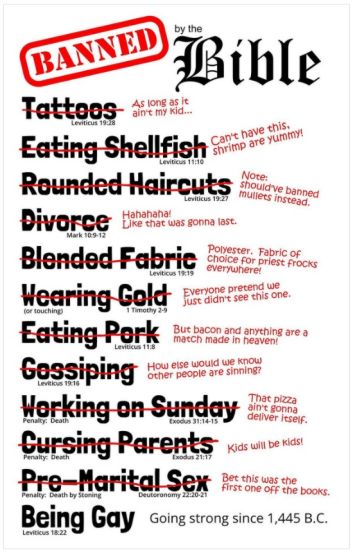
There will be innumerable times that you will come across miscellaneous posts on social media about how, the dietary restrictions herein contained are God’s laws, just as thou shalt not kill is. Mostly, I have seen the restrictions tied to homosexuality. “You think homosexuality is wrong? Well, do you eat shrimp? Then you really pick and choose which Bible verses to obey.” Or words to that effect.
So You Think Homosexuality Is Sinful? (A graphic); from the Scott Smith Blog; accessed September 24, 2023. I think Smith on his page approaches this from a Catholic viewpoint; but it is a reasonable approach.
Banned in the Bible (a graphic); from Tumblr accessed September 24, 2023.
There are quite a number of graphics like this found on the internet. Sometimes they are true, sometimes partially true, and sometimes misleading.
In the New Testament, we can eat shellfish and other foods which are unclean. Even in the Old Testament, there was not any sort of punishment prescribed for someone who was caught eating shrimp or pork.
Being tempted in the realm of homosexuality (that is, being gay) is not banned in Scripture. Acts of homosexuality are taught as being sinful in both the Old and New Testaments. There are a number of reasons which can cause a person to have homosexual desires. Sometimes, if a person’s first sexual experience is with a person of the same sex, this mars that person for life (which is one reason why the gay movement goes after children). Wearing gold is not prohibited in Scripture; but women are not to adorn themselves with an emphasis upon the exterior (which includes jewelry).
My primary reason for posting this and the other graphics is to show how the homosexual and pan sexual movement tries to present homosexual actions as being equivalent to wearing a cotton blend shirt or to eating a pulled pork sandwich. These things are entirely different and under the Mosaic Law, the penalty for committing a homosexual act is death. Under the Mosaic Law, no one would be executed for eating a slice of bacon.
What Shall We Eat? (A chart); from Pinterest; accessed September 17, 2020.
Essentially, what we are studying is this chart, although this chapter focuses upon the meats which are clean and unclean.
I did a great deal of reading on this particular topic and ran into a particular interesting approach which sounds reasonable, but is wrong.
When it comes to determining what we as believers can do or not do, we have to be careful not to simply divide the Bible into the Old and New Testaments. It is not quite as simple as the Old Testament is for the Jews and the New Testament is for Christians. In fact, a statement like that could not be more wrong.
What some have done with this approach is, they take the NT as a whole, and see that Jesus was following some dietary laws. So, they conclude, our mandate is to do what Jesus did. But, that is not our mandate.
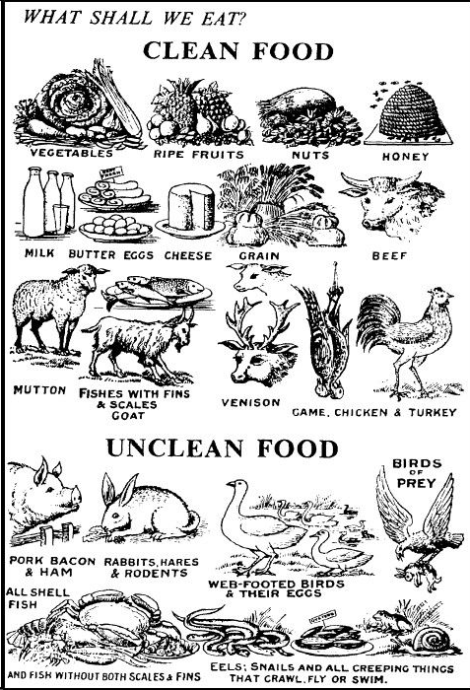
Jesus was under the Law and He did nothing to violate the Law. We are not under the Mosaic Law, so we can take exception to many of the things which we find in the Old Testament.
Most obviously, we do not sacrifice animals to God. Not only is that not required, it is forbidden of the Christian to do. If we offer up an animal sacrifice, that is sin, because we are attempting to crucify the Lord again.
Without necessarily specifying a particular passage, I can guarantee you that the Lord ate mutton but he did not eat pork. That is because He was under the Mosaic Law; and He completely fulfilled the Mosaic Law, making Him qualified (in one respect) to go to the cross. I am not under the Law; and I eat a lot of pork and almost no mutton (I have bought lamb only once or twice in my life). Obviously, I am not following the dietary habits of Jesus because He was under the Law and I am not.
The difference is dispensation. The Age of Israel continued from the calling of Abraham to the beginning of the earthly ministry of the Lord. Many consider the earthly ministry of the Lord to be a separate dispensation (and I am among those). Now, He is still under the Law, but Jesus teaches both the Law and He teaches specifics about the coming ages (which includes the Church Age). We might consider the Lord the hinge between the Age of Israel and the Church Age. He obeyed the laws of God; and, He was also empowered by God the Holy Spirit (which is what we have in the Church Age).
Originally, I was going to cite a particular webpage which covered clean and unclean animals, but then, read it more carefully and saw that they did not fully appreciate that Jesus was under the Mosaic Law (He was not under the customs exercised by the priests). Nor am I going to cite them as an example of what not to do or what not to believe. What is necessary for you is to understand the principles, and then evaluate what you read, study or hear according to those principles.
Within the confines of this study, it is worth asking, are these clean and unclean animals randomly chosen or can they be correlated with, say, health benefits? Turns out that there has been a great deal of research on this topic and the clean animals, even today, tend to be better for the health of the person who eats them; and the unclean animals worse (or, potentially worse, depending upon preservation methods used).
|
By the 1980s, all the health organizations of the United States had adopted low-fat, high fiber dietary guidelines. This was the culmination of numerous scientific studies that had demonstrated that diets high in vegetables, fruits, and grains reduced the risk of heart disease, cancer, and many other diseases. Secular physicians generally agree that these dietary guidelines that were producing longer life spans were first developed by religious movements founded in the 1800s, particularly by the Seventh-day Adventists. Where did the Seventh-day Adventists get their guidelines? From a meticulous and careful study of the Bible7. It appears man has finally caught up to the dietary recommendations given by God to the Israelites some 3500 years ago! |
7. The Biblical diet was primarily a vegetarian diet of vegetables, fruits, nuts, and grains. It wasn’t until after Noah’s Flood that God reluctantly allowed moderate consumption of meat (ingestion of fat remained strictly forbidden), though He still clearly indicated the superiority of vegetables over meat (see Daniel 1:12-15). For a detailed discussion, see Dr. Jerry Bergman’s report in the Creation Research Society Quarterly, Vol 34, No. 4, March 1998, pg 209. |
From https://bibleevidences.com/medical-evidence/ accessed December 19, 2020. |
|
Food regulations enumerated in the first five books of the Old Testament have been scrutinized by credentialed professionals in the fields of dietary and pathological research. The regulations have proven to coincide with modern science’s understanding of various aspects of health and disease prevention. In 1953, an extensive study, performed by David I. Macht and published in the Bulletin of the History of Medicine (a publication of the American Association of the History of Medicine and of The Johns Hopkins Institute of the History of Medicine), tested the toxicity of the meat of animals listed in Leviticus 11 and Deuteronomy 14. Macht’s technique was to place a certain seedling (Lupinus albus) in fresh muscle juices of the various animals noted as clean and unclean in the biblical text. This method was used at the time to study the blood of normal human patients as compared to the blood of cancerous patients (1953, p. 444). Macht noted that his results revealed “data which are of considerable interest not only to the medical investigator but also to the students of ancient Biblical literature” (p. 445). Some of his results were indeed of interest. For instance, he would take a control group of seedlings that grew in normal solutions and compare that group to seedlings placed in the various meat juices. He would then record the percent of seeds that grew in the meat juices as compared to those that grew under normal circumstances. For example, when placing the seedlings in meat juices from the Ox, the seeds grew 91% as often as they would if placed in a regular growing solution. Seeds in sheep juices grew 94% as often as those in the control group in regular solution. Seedlings in meat juice from a calf—82%; from a goat—90%; and from a deer 90%. Since these animals chew the cud and have a divided hoof, they were listed as clean in Leviticus 11 and Deuteronomy 14:
Now the Lord spoke to Moses and Aaron, saying to them, “Speak to the children of Israel, saying, ‘These are the animals which you may eat among all the animals that are on the earth: Among the animals, whatever divides the hoof, having cloven hooves and chewing the cud—that you may eat’” (Leviticus 11:1-3). When several unclean animals were studied, however, they showed significantly higher levels of toxicity and much lower levels of seedling growth. Seedlings in meat juice from pigs grew only 54% as often as the control group under normal growing conditions; rabbit—49%; camel—41%; and horse—39%. These results for larger mammals suggested that the biblical division between clean and unclean could have been related to the toxicity of the juices of such animals. Macht did similar research on birds, in which he found that extracts from biblical clean birds such as the pigeon and quail grew his seedlings 93% and 89%, while those from unclean birds such as the Red-tail hawk (36%) and owl (62%) were much more toxic. As Moses said: “And these you shall regard as an abomination among the birds; they shall not be eaten, they are an abomination: the eagle, the vulture, the buzzard, the kite, and the falcon after its kind; every raven after its kind, the ostrich, the short-eared owl, the sea gull, and the hawk after its kind” (Leviticus 11:13-19). Other studies included several different kinds of fish. The biblical regulation for eating fish was that the Israelites could eat any fish that had fins and scales (Deuteronomy 14:9). Those water-living creatures that did not possess fins and scales were not to be eaten (14:10). In regard to his study on the toxicity of fish, Macht wrote:
Of special interest were experiments made with muscle juices and also blood solutions obtained from many species of fishes. Fifty-four species of fishes were so far studied in regard to toxicity of meat extracts. It was found that the muscle extracts of those fishes which possess scales and fins were practically non-toxic [Herring—100%; Pike—98%; Shad—100%—KB], while muscle extracts from fishes without scales and fins were highly toxic for the growth of Lupinus albus seedlings (pp. 446-448). Macht’s study, even after more than five decades, continues to remain of great interest. His rigorous research led him to conclude:
The observations described above corroborate the impression repeatedly made on the author in investigations as a physician (M.D. Johns Hopkins, 1906), as an experimental biologist (Member of Society for Experimental Biology and Medicine), and as Doctor of Hebrew Literature (Yeshiva University, 1928) that all allusions of the Book of Books, to nature, natural phenomena, and natural history, whether in the form of factual statements or in the form of metaphors, similes, parables, allegories, or other tropes are correct either literally or figuratively.... Such being the extraordinary concordance between the data of the Scriptures and many of the modern and even most recent discoveries in both the biological and physico-chemical sciences, every serious student of the Bible will, I believe, endorse the assertion of Sir Isaac Newton, that “The Scriptures of God are the most sublime philosophy. I find more such marks of authenticity in the Bible than in profane history anywhere” (p. 449). Some, however, have questioned Macht’s results. Prior research done by Macht in 1936 and 1949 produced discordant results from his research in 1953. But there are several compelling reasons for accepting Macht’s 1953 research. First, it could be the case that Macht’s 1953 research simply was more refined and the procedure better understood. As one would expect in the scientific field, research generally tends to improve with time. Second, Macht was a high-profile doctor with copious credentials. His research in 1936 and 1949 had been published and was easily accessible. Yet even though his previous research was available, the Johns Hopkins Institute considered it acceptable to publish his 1953 research, which would suggest that the 1953 research included additional methods and/or information that would override the earlier research. Third, Macht’s procedure as described in the 1953 paper was fairly simple and easily reproducible. But those who question the work have failed to produce experimental data after 1953 that would negate Macht’s study. If his 1953 procedures were fraught with error, a few simple experiments could be done to prove that. No such experimental data refuting Macht has been produced. For these reasons, the findings of Dr. Macht aid in the defense of the Bible’s inspiration and remarkably accurate medical procedures as far back as the time of Moses. But the validity of Old Testament food consumption laws certainly does not rely solely on Macht’s 1953 research. Additional confirmation of the beneficial, protective nature of Mosaic food consumption laws is readily available. |
From Apologetics Press; accessed December 20, 2020. |
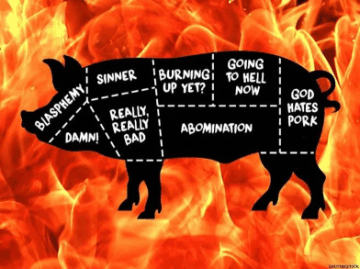
The pig is considered unclean to the Israelites. See Pett’s comment below.
Leviticus 11:7 [Finally,] the hog, for it parts the hoof but [its] cud is not brought up; [so] it is unclean to you+.
Pork will send you to hell (a graphic); from Advocate.com accessed September 24, 2023.
The dietary limitations did not send anyone to hell. There are no specific punishments which pork- eaters were subject to. God does not hate pork; and if you have eaten bacon, you know that it is not really, really bad.
In a world where certain animals were more likely to carry a number of diseases and actual pests, designating the hog as unclean meant that this was not eaten inside Israel. Therefore, as a result, Israelites are still with us today (which was the intention of this prohibition).
|
One of the most well-known Old Testament food regulations is the prohibition of pork consumption (Leviticus 11:7). Under close scrutiny, this prohibition exemplifies the value of the biblical laws regarding clean and unclean animals. During the days of Moses, proper food preparation and cooking conditions did not always exist. In fact, the general knowledge of the need to separate certain uncooked foods, especially meats, during preparation from other foods was virtually non-existent. Certain meats, if contacted raw or under-cooked, have greater potential to carry parasites and other harmful bacteria that can infect the end consumer (in this case, humans). Due to the fact that pigs are scavengers, and will eat practically anything, they often consume parasites and bacteria when they eat the carcasses of other dead animals. These parasites and bacteria can, and often do, take up residence in the pigs’ muscle tissue. Fully cooking the meat can kill these harmful organisms, but failure to cook the meat completely can cause numerous detrimental effects. R.K. Harrison listed several diseases or other health maladies that can occur due to the ingestion of improperly cooked pork. He noted that pigs often are the host of the tapeworm Taenia solium. Infection by this parasite can cause small tumors to arise throughout the body, including on the skin, eyes, and muscles. Furthermore, these tumors can affect the brain and cause epileptic convulsions. Additionally, humans can develop trichaniasis (trichinosis) infestation from eating undercooked, as well as tape worm known as Echiococcus granulosus from water polluted by pigs. Further, pigs can pass on the microorganisms that cause toxoplamosis, a disease affecting the nervous system (Harrison, 1982, p. 644). Due to a much more exhaustive body of knowledge concerning parasites and pathogens, modern readers are increasingly attune to the dangers of consuming raw or undercooked pork. In fact, most pork bought in grocery stores contains nitrates and nitrites that have been injected into the meat to hinder the growth of harmful microorganisms. But Moses and the Israelites did not have access to such modern knowledge. How is it that the food regulations recorded by Moses over 3,000 years ago contain such an accurate understanding of disease control? Albright noted along these lines, “thanks to the dietary and hygienic regulations of Mosaic law...subsequent history has been marked by a tremendous advantage in this respect held by Jews over all other comparable ethnic and religious groups” (1968, p. 181). |
From Apologetics Press; accessed December 20, 2020. |
Leviticus 11:4–7 The clean animals are those who both predigest their food and have split hooves. You will not eat the camel, the rock badger or the hare, because they all predigest their food but their hooves are not divided; they are unclean to you. Also, the hog is not to be eaten because it had split hooves but it does not predigest its food.
Dr. Peter Pett: And as it happens medically the pig, the rock badger and the hare can all commonly contribute to unpleasant diseases of one kind or another through parasitic infection, precisely as a result of their lifestyles, and while making them far safer, even modern methods of treatment can fail to remove totally these parasitic infections. Eating them would not necessarily result in such an infection, but there was a good likelihood that it would be so, far more so than with the clean animals. (We should also note that while the pig and the camel can be identified we are not absolutely certain as to the identity of the shaphan and the ’arnebeth which may be extinct).
Pett provides a general observation: There can be no question that those who observed these instructions would definitely on the whole have had better health, (and would also be wealthier by keeping their camels, which at that time were quite rare), than those who did not, especially in primitive conditions. It would seem that people did not think of eating asses as they are not mentioned. They were too valuable and useful for other purposes. They were to treat their camels as the same.
Any kind of life which lacks fins and scales was not to be eaten.
A Seafood Platter (a photograph); from Anne's Daily Bible Journal; accessed September 12, 2020.
This is a rather delectable platter of various kinds of sea food which is, for the Hebrew, living during the age of Israel, forbidden. Logically, this food is wonderful, if there is proper refrigeration. In so many markets, these various types of sea creatures are found either frozen or in a cold refrigerated space. For us, when such conveniences are common, this sort of food is fine for us to eat.
Leave this same food at room temperature for 2 or more days and is it still as appetizing? I would think not. I would also have some concerns regarding the safety of eating such food.
Interestingly enough, there are a number of Jews today who would not eat from this seafood platter, because they place themselves under the Law. Or how many have abandoned their incomplete faith because they tried a little crab meat or some shrimp and found such food to be delicious?
Just to make certain that you, as a Church Age believer understand—this seafood platter is for you. You see a wonderful tray of delectable foods like this, and you are allowed to partake. The Jew who places himself under the Law is not.
Let me also add that, close association with that which is unclean (eating unclean food or touching the carcass of something which is unclean) is on a different level from sinful acts, thoughts or words. Those unfamiliar with the Bible or who try to disparage the Bible often confuse these things.
Although there is clearly a spiritual aspect to what a Hebrew might eat or not eat under the economy of Israel, this equally protected them from eating food which could harm them as a people.
Those sea creatures which did not have scales or fins were to be treated as an abomination.
Leviticus 11:10 And all who do not have fins or scales, [whether] in the seas or torrents—of all who live [lit., swarm] in the waters and of every [kind of] life in the waters—they [are] an abomination to you+.
Not being a person who is fond of oysters, scallops or clams and being neutral concerning shrimp, I personally have no problems with this verse. However, we, as Christians, are allowed to eat of these unclean foods today.

Faith Schools—Homosexuality and Healthy School Dinners (a graphic); from the Guardian; accessed September 24, 2023.
I have no idea whether such cartoons are produced in ignorance, or they know the Bible position, but distort it. I would assume the former. Bear in mind the #1 intention here is to cause the believer to have less faith in his Bible.
“Your Bible says homosexuality is wrong? Well what about Shrimp Pasta? What about that?” This is very much the intent, as many people believe that the Bible is dated and/or wrong.
Let me provide an analogous situation of today. You may violate Facebook policy and be limited in your use of Facebook for a week. That is similar these limitations of food consumption in Leviticus. However, you may break a serious law and be classified a felon for doing so. That would be like violating the more substantial laws of Moses (for instance, committing adultery, stealing, having homosexual relations). The penalties are going to be considerably more for a felon convicted of a crime as over against a Facebook violation.
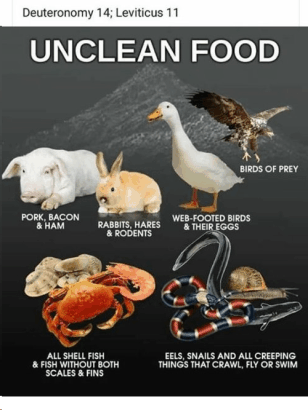
A summation of the clean and unclean animals:
We have a very specific way of classifying animals. Although there are similarities between scientific classification of animals; this is not what is adhered to in Scripture.
Leviticus 11:46 These [are] the laws of mammals, birds, and every living creature, those who swim [lit., creep, glide, move] in the waters and those which [lit., every soul of] crawl upon the earth;...
This is a summation of this chapter in the last two verse.
Unclean Food (a graphic); from The World News Media; accessed September 17, 2020.
This picture gives us a reasonable summary and grouping of the animals which are unclean.
I don’t know how much research has been done in this area, but my guess is, over the years, quite a bit. My guess would be, the percentage represents the goodness of the animal’s meat for human consumption, based upon the growth rate of bacteria within the animal itself. |
Why does the Bible forbid the eating of pork, shellfish, mice and ravens? Because these animals were never meant for human consumption. They were designed by Elohim to clean up the filth and rotting corpses of the world. Vayikra 11 and Deuteronomy 14 are both scientifically accurate and sound medical advice. Elohim designed everything in the universe, including our bodies. Don't you think He would know what is good (and bad) for it? Elohim never abolished His dietary laws,1 which were designed for the benefit of mankind. He designed our bodies, as well as the bodies of these animals that are deemed unclean. Take note: Keep in mind that the higher the percentage the less toxic to the human body. The lower the percentage the slower the growth rate of the culture and therefore the higher the toxicity of the sample being tested.2 Remember High percentage (76% and up)= good to human body) Low percentage (75% or less) = destructive and / or poisonous to human body Beast (clean) - herbivorous Calf 82% Deer 98% goat 90% ox 91% Sheep 94% - lamb chop lover Beast (unclean) Black bear 59% camel 41% cat 62% eat rats dog 62% - those who like to eat dog meat take note - scavengers, can be carnivorous. I remember I gave my dog eat raw flesh the bed bugs left the dogs body does not want to suck dog's blood. fox 58% grizzly beat 55% - carnivorous groundhog - 53% - pig family hamster 46% opossum 53% horse 39% - wow so toxic? herbivorous? Rabbit 49% - those who like rabbit meat rat - 55% - scavengers brings disease bubonic, remember the black death Rhino 60% squirrel 43% pig 54% - pork lovers porcupine - 60% Birds (clean) Goose 85% chicken 83% duck 98% pigeon 93% quails 89% Swan 89% - this is Chinese say want to eat tian er rou :-) Turkey 85% - yea going to have turkey for Hannukah?? Bird (unclean) Crow 46% - scavengers we can see many in our country just watch what they eat. Owl 62% - eat rats also carnivorous red tail hawk 36% - carnivorous - a type of eagle sparrow hawk 63% - carnivorous Fish (clean) with scale and fin notice fish has higher percentage than land animals3 Black bass 80% Black drum 105% Blue fish 80% carp 90% cod 98% white meat - quite expensive most mother use this to cook porridge for their children croaker 90% Halibut 82% Herring 100% - wow 100% pike 98% salmon 81% - not very high percentage it is orange meat. smelt 90% sea bass 103% - available at most supermarket Blue fin tuna - 88% - not high either dark red meat, Fish (unclean) without scale or no scale n fin Cat fish 48% eel 40% - it was said that during 2004 tsunami the eel was found eating dead human flesh - toxic pofeur 51% sand skate 59% - seabed cleaner? dogfish shark 62% stingray 40% - alas those who like eat stingray take note toxic toad fish 49% Yeshayahu 66:17 those who set themselves apart and cleanse themselves at the gardens after ‘One’ in the midst, eating flesh of pigs and the abomination and the mouse, are snatched away, together,” declares יהוה.
Background information about pigs in pagan practice and beliefs: Leviticus 11:7. pigs. Assyrian wisdom literature calls the pig unholy, unfit for the temple and an abomination to the gods. There is also one dream text in which eating pork is a bad omen. Yet it is clear that pork was a regular part of the diet in Mesopotamia. Some Hittite rituals require the sacrifice of a pig. Milgrom observes, however, that in such rituals the pig is not put on the altar as food for the god but absorbs impurity and then is burned or buried as an offering to underworld deities. Likewise in Mesopotamia it was offered as a sacrifice to demons. There is evidence in Egypt of pigs used for food, and Herodotus claims they were used for sacrifice there as well. Egyptian sources speak of herds of swine being kept on temple property, and they were often included in donations to the temples. The pig was especially sacred to the god Seth. Most evidence for the sacrifice of pigs, however, comes from Greece and Rome, there also mostly to gods of the underworld. In urban settings pigs along with dogs often scavenged in the streets, making them additionally repulsive. The attitude toward the pig in Israel is very clear in Isaiah 65:4; Isaiah 66:3, Isaiah 66:17, the former showing close connection to worship of the dead. It is very possible then that sacrificing a pig was synonymous with sacrificing to demons or the dead. CLEAN AND UNCLEAN ANIMALS (ON THE LAND) Elohim draws a strict line of demarcation between light and darkness, night and day, black and white, right and wrong, clean and unclean. Elohim makes the rules, and man must make his decisions according to God's rules. |
From WIkipedia: Macht was an Orthodox Jew and a Doctor of Hebrew Literature, and he frequently advocated the position that there was a harmonious relationship between religion and science. He studied medical and other descriptions in the Bible and the Talmud, and published many papers that claimed to show that these were accurate descriptions of diseases or treatments,...[such as] "An Experimental Pharmacological Appreciation of Leviticus XI and Deuteronomy XIV" (1953). In which Macht used his phytopharmacology technique on samples of both Levitically clean and unclean animals, and showed a markedly higher phytotoxic index for the unclean meats and the correlation was 100%. |
Based upon the Wikipedia article, Macht made quite a number of important medical discoveries and did a great deal of research. His founding principles include the idea that Scripture is closely aligned with science. |
1 No doubt, Macht speaks here as a Jew, and does not believe the New Testament to be inspired by Elohim. 2 Macht does not really explain how he goes from the culture growth and the toxicity of an animal to the percentages here. Perhaps he goes into great depth in his books. 3 Macht references http://www.messianic-torah-truth-seeker.org/Torah/Kashrut/Tahor-clean-Scaled-fish.htm |
From https://www.messianic-torah-truth-seeker.org/Torah/Kashrut/Elohim-Dietary-Laws.html accessed September 19, 2020. I did some minor editing. |
Clean and Unclean Meats (a graphic); from the United Church of God; accessed September 17, 2020.
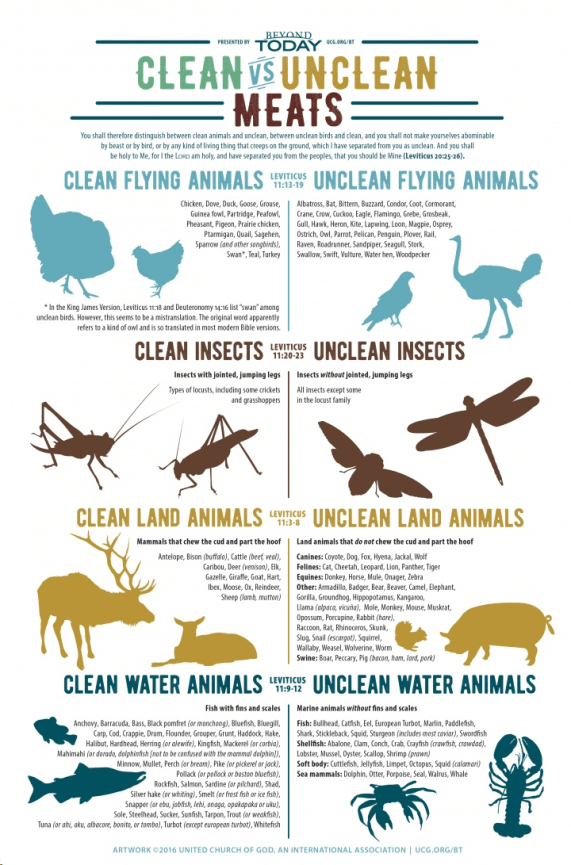
|
|
Category |
Clean |
Mammals That Chew the Cud and Part the Hoof |
Antelope, Bison (buffalo), Caribou, Cattle (beef, veal), Deer (venison), Elk, Gazelle, Giraffe, Goat, Hart, Ibex, Moose, Ox, Reindeer, Sheep (lamb, mutton) |
Fish With Fins and Scales |
Anchovy, Barracuda, Bass, Black pomfret (or monchong), Bluefish, Bluegill, Carp, Cod, Crappie, Drum, Flounder, Grouper, Grunt, Haddock, Hake, Halibut, Hardhead, Herring (or alewife), Kingfish, Mackerel (or corbia), Mahimahi (or dorado, dolphinfish [not to be confused with the mammal dolphin]), Minnow, Mullet, Perch (or bream), Pike (or pickerel or jack), Pollack (or pollock or Boston bluefish), Rockfish, Salmon, Sardine (or pilchard), Shad, Silver hake (or whiting), Smelt (or frost fish or ice fish), Snapper (or ebu, jobfish, lehi, onaga, opakapaka or uku), Sole, Steelhead, Sucker, Sunfish, Tarpon, Trout (or weakfish), Tuna (or ahi, aku, albacore, bonito, or tombo), Turbot (except European turbot), Whitefish |
Birds With Clean Characteristics |
Chicken, Dove, Duck, Goose, Grouse, Guinea fowl, Partridge, Peafowl, Pheasant, Pigeon, Prairie chicken, Ptarmigan, Quail, Sagehen, Sparrow (and other songbirds), Swan*, Teal, Turkey |
Insects |
Types of locusts that may include crickets and grasshoppers |
* In the King James Version, Leviticus 11:18 and Deuteronomy 14:16 list "swan" among unclean birds. However, this seems to be a mistranslation. The original word apparently refers to a kind of owl and is so translated in most modern Bible versions. |
From UCG.org; accessed September 17, 2020. |
|
|
Category |
Unclean |
Swine |
Boar, Peccary, Pig (hog, bacon, ham, lard, pork, most sausage and pepperoni) |
Canines |
Coyote, Dog, Fox, Hyena, Jackal, Wolf |
Felines |
Cat, Cheetah, Leopard, Lion, Panther, Tiger |
Equines |
Donkey (ass), Horse, Mule, Onager, Zebra (quagga) |
Other Animals |
Armadillo, Badger, Bat, Bear, Beaver, Camel, Elephant, Gorilla Groundhog, Hippopotamus, Kangaroo, Llama (alpaca, vicuña), Mole, Monkey, Mouse, Muskrat, Opossum, Porcupine, Rabbit (hare), Raccoon, Rat, Rhinoceros, Skunk, Slug, Snail (escargot), Squirrel, Wallaby, Weasel, Wolverine, Worm, All insects except some in the locust family |
Marine Animals Without Fins and Scales — Fish |
Bullhead, Catfish, Eel, European Turbot, Marlin, Paddlefish, Shark, Stickleback, Squid, Sturgeon (includes most caviar), Swordfish |
Marine Animals Without Fins and Scales — Shellfish |
Abalone, Clam, Conch, Crab, Crayfish (crawfish, crawdad), Lobster, Mussel, Oyster, Scallop, Shrimp (prawn) |
Marine Animals Without Fins and Scales — Soft body |
Cuttlefish, Jellyfish, Limpet, Octopus, Squid (calamari) |
Marine Animals Without Fins and Scales — Sea mammals |
Dolphin, Otter, Porpoise, Seal, Walrus, Whale |
Birds of Prey, Scavengers and Others |
Albatross, Bittern, Buzzard, Condor, Coot, Cormorant, Crane, Crow, Cuckoo, Eagle, Flamingo Grebe, Grosbeak, Gull, Hawk, Heron, Kite, Lapwing, Loon, Magpie, Osprey, Ostrich, Owl, Parrot, Pelican, Penguin, Plover, Rail, Raven, Roadrunner, Sandpiper, Seagull, Stork, Swallow, Swift, Vulture, Water hen, Woodpecker |
Reptiles |
Alligator, Caiman, Crocodile, Lizard, Snake, Turtle |
Amphibians |
Blindworm, Frog, Newt, Salamander, Toad |
From UCG.org; accessed September 17, 2020. |
From Messianic Torah Truth Seeker, accessed September 19, 2020. |
|
|
|
|
|
|